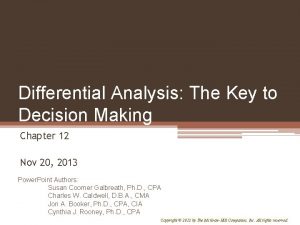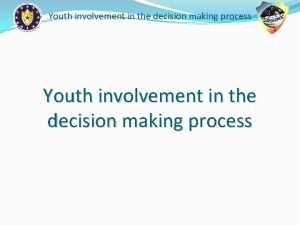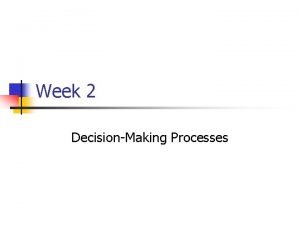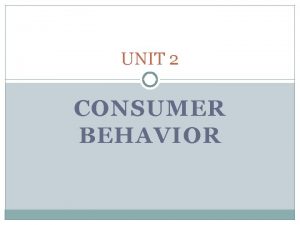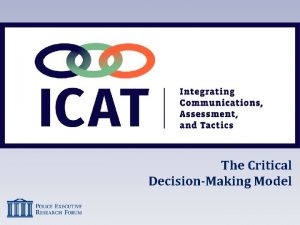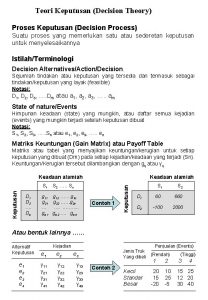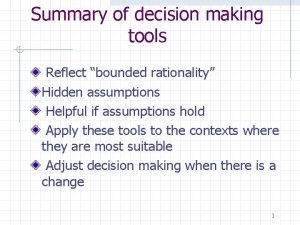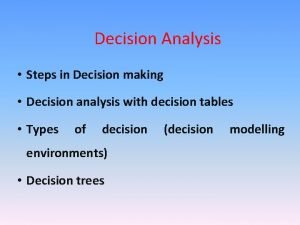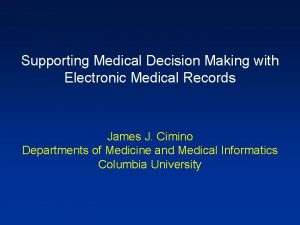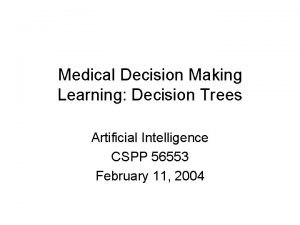Decision Analysis Aspects of Medical Decision Making Gordon






























- Slides: 30

Decision Analysis: Aspects of Medical Decision Making Gordon Hazen Northwestern University

Contributions ¡ Decision analysis has contributed to decision-making in business, medicine, engineering, and law medicine, Stanford University October 2011 2

My Input to Today’s Discussion The field of medical decision making ¡ Relationships between medical decision analysis and the broader DA field ¡ A nonscientific report based on my impressions only … ¡ Stanford University October 2011 3

The Field of Medical Decision Making ¡ ¡ ¡ Modeling to aid diagnostic and therapeutic choice by physicians and treatment choice by patients Cost-effectiveness modeling to inform public policy Decision psychology: Understanding/ predicting patient and physician choices Stanford University October 2011 4

Relationships Statistics Health Economics Cost -Effectiveness Analysis Medical Decision Analysis Decision Psychology Decision Analysis Stanford University October 2011 5

Is methodological preparation enough? ¡ No: Medical DA researchers are almost always attached to institutions serving real-world stakeholders l l l l Bloomberg School of Public Health Center for Disease Control and Prevention Centre for Evaluation of Medicines (CEM), Cleveland Clinic Dept. of Social Medicine Erasmus University Medical School Center for Health Policy, Palo Alto, CA Institute for Health, Health Care Policy and Aging Research Mayo Clinic MD Anderson Cancer Center Merck Minneapolis VA Ctr Portland VA Medical Ctr VA San Diego Healthcare System Stanford University October 2011 6

Journals ¡ Publication of clinical decision analyses in medical journals is widespread l l l Frequently involve decision trees dovetailing into Markov models Pub. Med search for 2010 with abstracts containing “Markov”: 1426 papers! Pub. Med search for 2010 with abstracts containing “Markov” and titles containing “Effectiveness”: 200 papers. Stanford University October 2011 7

Journals ¡ Journals with methodological focus l l l Medical Decision Making Value in Health International J. of Technology Assessment in Health Care Health Economics J. of Health Economics Medical Care Stanford University October 2011 8

Examples of research (last three issues of Medical Decision Making) ¡ Decision Psychology l l l ¡ Dynamics of Trust in Medical Decision Making: An Experimental Investigation into Underlying Processes The 1 -in-X Effect on the Subjective Assessment of Medical Probabilities The Decision Making Control Instrument to Assess Voluntary Consent The Influence of Narrative v. Statistical Information on Perceiving Vaccination Risks Information for Decision Making by Patients With Early-Stage Prostate Cancer: A Comparison Across 9 Countries Impact on Decisions to Start or Continue Medicines of Providing Information to Patients about Possible Benefits and/or Harms: A Systematic Review and Meta-Analysis Preferences and Utilities l l l Estimation of a Preference-Based Carer Experience Scale Eliciting Benefit–Risk Preferences and Probability-Weighted Utility Using Choice-Format Conjoint Analysis Predicting EQ-5 D Utility Scores from the Seattle Angina Questionnaire in Coronary Artery Disease: A Mapping Algorithm Using a Bayesian Framework Stanford University October 2011 9

Examples of research (last three issues of Medical Decision Making) ¡ Provider Decision Making l l ¡ Shared Decision Making l l ¡ How Long and How Well: Oncologists’ Attitudes Toward the Relative Value of Life. Prolonging v. Quality of Life-Enhancing Treatments Deceiving Numbers: Survival Rates and Their Impact on Doctors’ Risk Communication Electronic Notifications about Drug Substitutes Can Change Physician Prescription Habits: A Cross-Sectional Observational Study Overestimation Error and Unnecessary Antibiotic Prescriptions for Acute Cystitis in Adult Women Longitudinal Changes in Patient Distress following Interactive Decision Aid Use among BRCA 1/2 Carriers: A Randomized Trial Are There Racial Differences in Patients’ Shared Decision-Making Preferences and Behaviors among Patients with Diabetes? Risk Communication l l l Informing Patients: The Influence of Numeracy, Framing, and Format of Side Effect Information on Risk Perceptions Influence of Graphic Format on Comprehension of Risk Information among American Indians Graph Literacy: A Cross-Cultural Comparison Stanford University October 2011 10

Examples of research (last three issues of Medical Decision Making) ¡ Exploring model structure l l l l A Systematic Comparison of Microsimulation Models of Colorectal Cancer: The Role of Assumptions about Adenoma Progression Clarifying Differences in Natural History between Models of Screening: The Case of Colorectal Cancer How Does Early Detection by Screening Affect Disease Progression? : Modeling Estimated Benefits in Prostate Cancer Screening Simulation of Quality-Adjusted Survival in Chronic Diseases: An Application in Type 2 Diabetes Bayesian Inference for Comorbid Disease Risks Using Marginal Disease Risks and Correlation Information From a Separate Source Can Life Expectancy and QALYs Be Improved by a Framework for Deciding Whether to Apply Clinical Guidelines to Patients With Severe Comorbid Disease? Integrating Health Economics Into the Product Development Cycle: A Case Study of Absorbable Pins for Treating Hallux Valgus Stanford University October 2011 11

Examples of research (last three issues of Medical Decision Making) ¡ Calibrating models l l ¡ Estimating the Unknown Parameters of the Natural History of Metachronous Colorectal Cancer Using Discrete-Event Simulation Bayesian Calibration of a Natural History Model with Application to a Population Model for Colorectal Cancer Representing Uncertainty in Models l l A Concise Equation That Captures the Essential Elements of One-Way Sensitivity Analyses in Health Economic Models The Combined Analysis of Uncertainty and Patient Heterogeneity in Medical Decision Models A Framework for Addressing Structural Uncertainty in Decision Models Accounting for Methodological, Structural, and Parameter Uncertainty in Decision-Analytic Models: A Practical Guide Stanford University October 2011 12

Activity: SMDM versus INFORMS DA Cluster ¡ SMDM 2006 l l 314 Abstracts 67 DA or C/E applications 13 DA or C/E methodology 127 utility/ preference/ dec’n psychology ¡ INFORMS DA cluster 2006 l 93 Abstracts 26 DA applications l 72 DA methodology l 8 utility/ preference/ dec’n psychology l SMDM = Society for Medical Decision Making C/E = Cost-effectiveness Stanford University October 2011 13

Activity (Based on SMDM 2006 participation) ¡ US l l l l l ¡ Harvard School of Public Health Stanford University Tufts-New England Medical Center Boston University Centers for Disease Control and Prevention Case Western Reserve University School of Medicine University of Pittsburgh University of Chicago Dartmouth Medical School Duke University UK/Europe l l ¡ University of Birmingham University of York University of Sheffield University Medical Centre Utrecht Canada l l l Stanford University October 2011 University of Toronto Mc. Master University of British Columbia Univ of Western Ontario University of Ottawa Dalhousie University 14

Academic Preparation SMDM Associate Editors: Ph. D areas ¡ ¡ ¡ Psychology (4) Epi-Biostat (2) Economics (6) l l l ¡ Health Policy (2) Health Econ (2) Health Technology Assessment (2) MD (4) Stanford University October 2011 15

Academic Preparation: What do these areas have in common? Decision Psychology Applied Math/Stat/OR Values and decisions under uncertainty Economics Stanford University October 2011 Health 16

Impacts of the DA field on medical decision making ¡ Decision psychology/ judgment and decision making l ¡ Thriving. Active research contributions. Prescriptive decision analysis l l l Basics understood and accepted Nuances not broadly understood Sophisticated tools not used in practice Stanford University October 2011 17

Impacts of prescriptive DA on the medical field ¡ Basics understood, accepted and used l l Probability, utility Decision trees ¡ l l l Tree. Age software quite popular Markov chains Sensitivity analysis Information value Probabilistic sensitivity analysis Bayesian probability and statistics Stanford University October 2011 18

Impacts of prescriptive DA on the medical field ¡ Stanford University October 2011 19

Impacts of prescriptive DA on the medical field ¡ Nuances are not broadly appreciated l The connection between preference assumptions on the one hand, and expected utility/ expected utility decomposition on the other. ¡ ¡ l Substitution/Independence (von Neuman & Morganstern) Utility independence The “preference assumptions utility decomposition” game is not understood or played. Exceptions: ¡ ¡ ¡ Pliskin, Shepard, Weinstein Wakker Miyamoto Stanford University October 2011 20

Impacts of prescriptive DA on the medical field ¡ Sophisticated tools not employed l l Influence diagrams Utility decompositions beyond additive ¡ l l l One key exception: HUI (Feeney, Torrence, Furlong) Copulas for constructing joint probability distributions Scoring rules Risk tolerance Stochastic dominance Combining expert judgments Stanford University October 2011 21

Impacts of prescriptive DA: Current research on QALYs ¡ Stanford University October 2011 22

QALYs: More for the prescriptive DA field to do? ¡ Mc. Horney 2004 l l l ¡ Fryback 2004 l ¡ Close to two dozen generic QOL instruments Hundreds of disease-specific instruments In cancer, over 75 different QOL measures exist 83 instruments for “General status and quality of life” 6 generic instruments widely adopted l l l 36 -Item Short Form Health Survey (SF-36) WHOQOL-BREF Quality of Life Assessment Quality of Well-Being scale (QWB-SA) Euro. Qol EQ-5 D Health Utilities Index Mark 2 and Mark 3 SF-6 D, a preference-based measure derived from the SF-36 Stanford University October 2011 23

QALYs: More for the prescriptive DA field to do? ¡ ¡ ¡ Instrument developers use psychometric techniques l classical test theory (CTT) l item response theory (IRT) … to assess reliability, validity, difficulty, stability These are not tasks for prescriptive DA. Stanford University October 2011 24

QALYs: More for the prescriptive DA field to do? Important issues: ¡ ¡ Community preferences vs. preferences of those who have experienced a health state? (see Drummond 2009 ) Different methods for valuing health yield different results l l ¡ ¡ Consensus that a standardized “reference method” is required for assessing QALYs Reluctance to endorse “yet another summary measure” (Fryback 2004) l l ¡ Standard gamble Time tradeoff Rating scale Person tradeoff loss in ability to compare to previous research findings Measure would not be universally adopted These are not prescriptive DA issues … Stanford University October 2011 25

Health as a multiattribute concept ¡ ¡ This is universally agreed to be the case. Existing instruments all have multiple dimensions/attributes l ¡ ¡ but not the same ones … HUI 2/3 both already based on multiattribute utility theory More for prescriptive DA to do? Maybe not? l l Reluctance to endorse “yet another summary measure” Anything more complicated than additive or multiplicative might be too much of a “black box” to be accepted by practitioners Stanford University October 2011 26

ISPOR Development Workshop 2007 on “Moving the QALY Forward: Building a Pragmatic Road” ¡ Eight-Item Consensus statement 1. 2. 3. 4. QALYs are a health-based input, but there are other inputs to health decisions. QALYs can be used for population-wide and individual health decisions Little is known about the relationship between health and general well-being Who should provide health value inputs? a) b) 5. Those who have experienced the health state? Representative sample of community members? Distributive/ equity issues need to be addressed. Stanford University October 2011 27

ISPOR Development Workshop 2007 on “Moving the QALY Forward: Building a Pragmatic Road” ¡ Eight-Item Consensus statement 6. 7. A need to better understand why different methods of QALY assessment give different answers Need for better ways to aggregate health impacts over time HYEs theoretically superior but practically infeasible 8. ¡ A “Reference Method” is needed for QALYs Which of these issues can be addressed by prescriptive DA? l l Distributive/equity issues? Health impacts over time? Stanford University October 2011 28

Summary ¡ Decision psychology continues to make contributions to medical decision analysis l l ¡ Prescriptive DA forms the basis for medical DA l l ¡ Decision psychology Preference/ utility Shared decision making Risk communication Basic concepts and tools widely used More sophisticated methods not understood and not applied Health quality (QALYs) l l Some opportunities for prescriptive DA contributions The biggest stumbling blocks to progress do not appear solvable by prescriptive DA Stanford University October 2011 29

Questions/ comments to follow … Stanford University October 2011 30
 Objectives of decision making
Objectives of decision making Slidetodoc.com
Slidetodoc.com Swot analysis decision making
Swot analysis decision making Contribution analysis in decision making
Contribution analysis in decision making Differential analysis: the key to decision making
Differential analysis: the key to decision making Differential analysis the key to decision making
Differential analysis the key to decision making What is inference
What is inference War making and state making as organized crime summary
War making and state making as organized crime summary Youth involvement
Youth involvement Nasw code of ethics
Nasw code of ethics Systematic decision making process
Systematic decision making process Paced decision making
Paced decision making Using recursion in models and decision making
Using recursion in models and decision making Using functions in models and decision making
Using functions in models and decision making Defining moments
Defining moments Unit 4 lesson 1 decision making
Unit 4 lesson 1 decision making How to improve marketing performance
How to improve marketing performance Types of decision making
Types of decision making Higher business decision making
Higher business decision making Decision making unit example
Decision making unit example Unstructured decision
Unstructured decision Marketing research functions
Marketing research functions Ask model
Ask model Contoh soal minimax regret
Contoh soal minimax regret Tactical decision making adalah
Tactical decision making adalah What is the dare decision making model
What is the dare decision making model Bounded rationality
Bounded rationality Mintzberg's modes of strategic decision making
Mintzberg's modes of strategic decision making Paced decision making
Paced decision making Chapter 6 prices and decision making assessment answers
Chapter 6 prices and decision making assessment answers Decision making conditions
Decision making conditions




